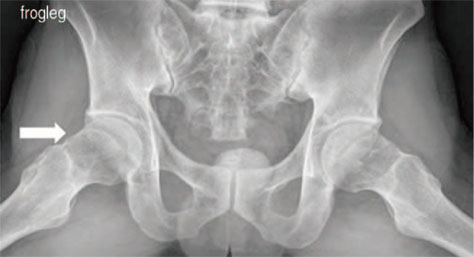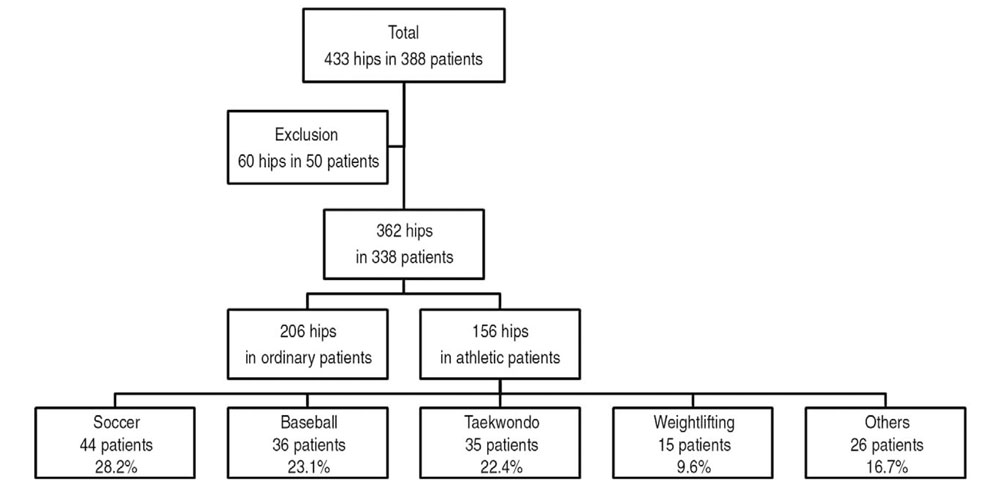Hip Pelvis.
2016 Mar;28(1):29-34. 10.5371/hp.2016.28.1.29.
Descriptive Epidemiology of Symptomatic Femoroacetabular Impingement in Young Athlete: Single Center Study
- Affiliations
-
- 1Department of Orthopedic Surgery, Chungnam National University School of Medicine, Daejeon, Korea. dshwang@cnu.ac.kr
- KMID: 2161312
- DOI: http://doi.org/10.5371/hp.2016.28.1.29
Abstract
- PURPOSE
The purpose of this study was to determine the prevalence of symptomatic femoroacetabular impingement (FAI) in athletic patients.
MATERIALS AND METHODS
From July 2003 to May 2013, 388 patients (422 hips) who underwent arthroscopic surgery for FAI were evaluated demographic characteristics. The patients' age, gender, diagnosis, and type of sports were analyzed using medical records and radiography.
RESULTS
Among 422 hips in 388 patients, 156 hips were involved with sports. Among the 156 hips, 86, 43, and 27 hips were categorized as cam, pincer, and mixed type, respectively. Types of sports were soccer, baseball and taekwondo which showed 44, 36 and 35 hips, respectively. Also, cases related to sports according to age were 63 hips for twenties and 12 hips for teenagers in which the two showed highest association to FAI. The kinds of sports that showed high association were 28 hips of soccer and 20 cases of martial arts such as taekwondo and judo for twenties and 9 hips of martial arts for teenagers which was the highest.
CONCLUSION
FAI usually occurs in young adults and is highly related to sports activity. Most of the FAI type related to sports activity was cam type, and soccer and martial arts such as taekwondo were the most common cause of it.
Keyword
MeSH Terms
Figure
Reference
-
1. Ganz R, Parvizi J, Beck M, Leunig M, Nötzli H, Siebenrock KA. Femoroacetabular impingement: a cause for osteoarthritis of the hip. Clin Orthop Relat Res. 2003; (417):112–120.2. Tanzer M, Noiseux N. Osseous abnormalities and early osteoarthritis: the role of hip impingement. Clin Orthop Relat Res. 2004; (429):170–177.3. Tönnis D, Heinecke A. Acetabular and femoral anteversion: relationship with osteoarthritis of the hip. J Bone Joint Surg Am. 1999; 81:1747–1770.4. Altenberg AR. Acetabular labrum tears: a cause of hip pain and degenerative arthritis. South Med J. 1977; 70:174–175.5. Anderson K, Strickland SM, Warren R. Hip and groin injuries in athletes. Am J Sports Med. 2001; 29:521–533.
Article6. Philippon MJ, Schenker ML. Arthroscopy for the treatment of femoroacetabular impingement in the athlete. Clin Sports Med. 2006; 25:299–308.
Article7. Bizzini M, Notzli HP, Maffiuletti NA. Femoroacetabular impingement in professional ice hockey players: a case series of 5 athletes after open surgical decompression of the hip. Am J Sports Med. 2007; 35:1955–1959.
Article8. Kang C, Hwang DS, Cha SM. Acetabular labral tears in patients with sports injury. Clin Orthop Surg. 2009; 1:230–235.
Article9. Laude F, Boyer T, Nogier A. Anterior femoroacetabular impingement. Joint Bone Spine. 2007; 74:127–132.
Article10. Takeyama A, Naito M, Shiramizu K, Kiyama T. Prevalence of femoroacetabular impingement in Asian patients with osteoarthritis of the hip. Int Orthop. 2009; 33:1229–1232.
Article11. Klaue K, Durnin CW, Ganz R. The acetabular rim syndrome. A clinical presentation of dysplasia of the hip. J Bone Joint Surg Br. 1991; 73:423–429.
Article12. Beck M, Kalhor M, Leunig M, Ganz R. Hip morphology influences the pattern of damage to the acetabular cartilage: femoroacetabular impingement as a cause of early osteoarthritis of the hip. J Bone Joint Surg Br. 2005; 87:1012–1018.13. Tönnis D. Normal values of the hip joint for the evaluation of X-rays in children and adults. Clin Orthop Relat Res. 1976; (119):39–47.14. Nötzli HP, Wyss TF, Stoecklin CH, Schmid MR, Treiber K, Hodler J. The contour of the femoral head-neck junction as a predictor for the risk of anterior impingement. J Bone Joint Surg Br. 2002; 84:556–560.
Article15. Tannast M, Siebenrock KA. Conventional radiographs to assess femoroacetabular impingement. Instr Course Lect. 2009; 58:203–212.16. Reynolds D, Lucas J, Klaue K. Retroversion of the acetabulum. A cause of hip pain. J Bone Joint Surg Br. 1999; 81:281–288.17. Wiberg G. Studies on dysplastic acetabula and congenital subluxation of the hip joint with special reference to the complication of osteo-arthritis. Acta Chir Scand. 1939; 58:Suppl. 1–135.18. Tannast M, Siebenrock KA, Anderson SE. Femoroacetabular impingement: radiographic diagnosis--what the radiologist should know. AJR Am J Roentgenol. 2007; 188:1540–1552.
Article19. Ekström H, Elmståhl S. Pain and fractures are independently related to lower walking speed and grip strength: results from the population study "Good Ageing in Skåne". Acta Orthop. 2006; 77:902–911.
Article20. Philippon M, Schenker M, Briggs K, Kuppersmith D. Femoroacetabular impingement in 45 professional athletes: associated pathologies and return to sport following arthroscopic decompression. Knee Surg Sports Traumatol Arthrosc. 2007; 15:908–914.
Article21. McCarthy J, Barsoum W, Puri L, Lee JA, Murphy S, Cooke P. The role of hip arthroscopy in the elite athlete. Clin Orthop Relat Res. 2003; (406):71–74.
Article22. Siebenrock KA, Ferner F, Noble PC, Santore RF, Werlen S, Mamisch TC. The cam-type deformity of the proximal femur arises in childhood in response to vigorous sporting activity. Clin Orthop Relat Res. 2011; 469:3229–3240.
Article23. Siebenrock KA, Kaschka I, Frauchiger L, Werlen S, Schwab JM. Prevalence of cam-type deformity and hip pain in elite ice hockey players before and after the end of growth. Am J Sports Med. 2013; 41:2308–2313.
Article24. Byrd JW, Jones KS. Hip arthroscopy in athletes. Clin Sports Med. 2001; 20:749–761.
Article
- Full Text Links
- Actions
-
Cited
- CITED
-
- Close
- Share
- Similar articles
-
- Femoroacetabular Impingement Syndrome
- Controversial Issues in Arthroscopic Surgery for Femoroacetabular Impingement
- Descriptive Epidemiology of Patients Undergoing Total Hip Arthroplasty in Korea with Focus on Incidence of Femoroacetabular Impingement: Single Center Study
- Efficacy of Intra-articular Steroid Injection in Patients with Femoroacetabular Impingement
- Acetabular Labral Tears in Patients with Sports Injury





